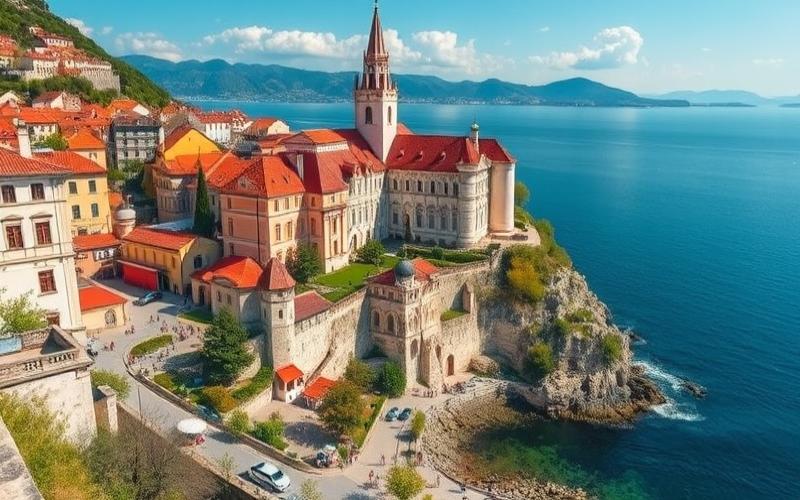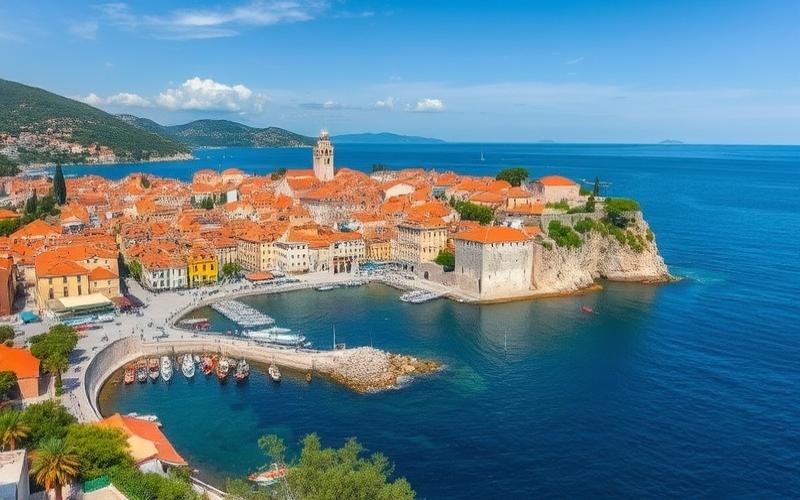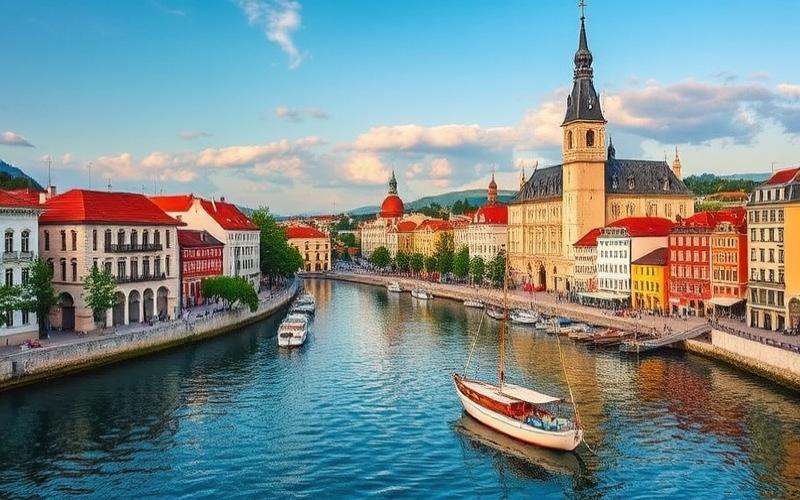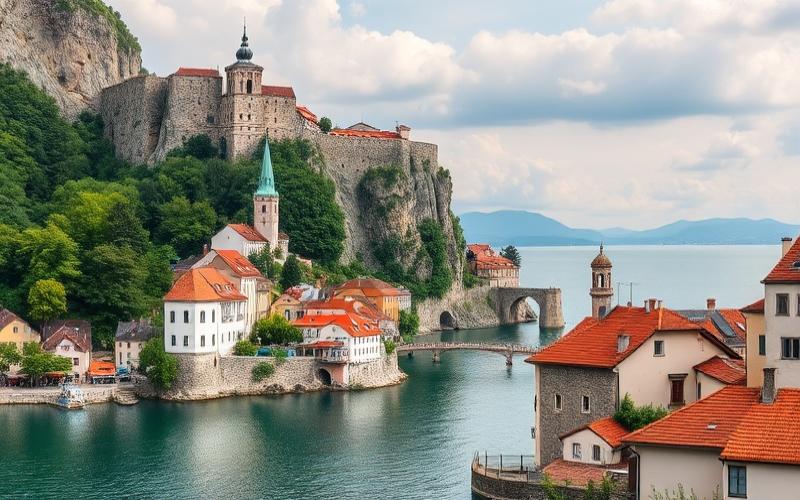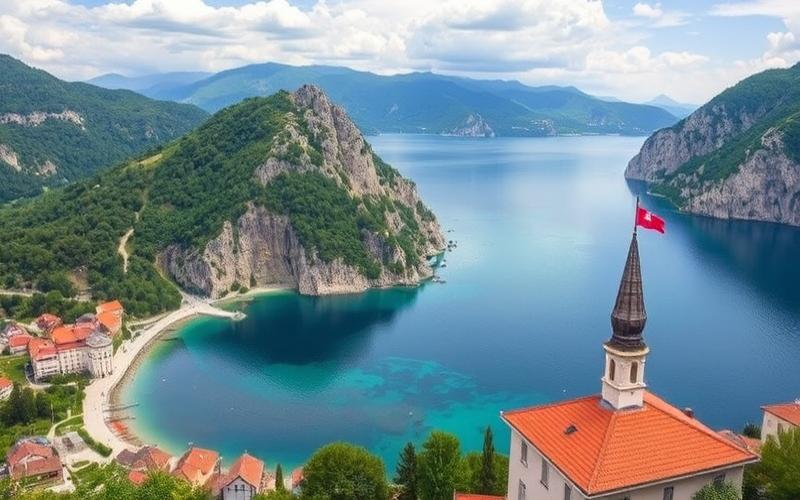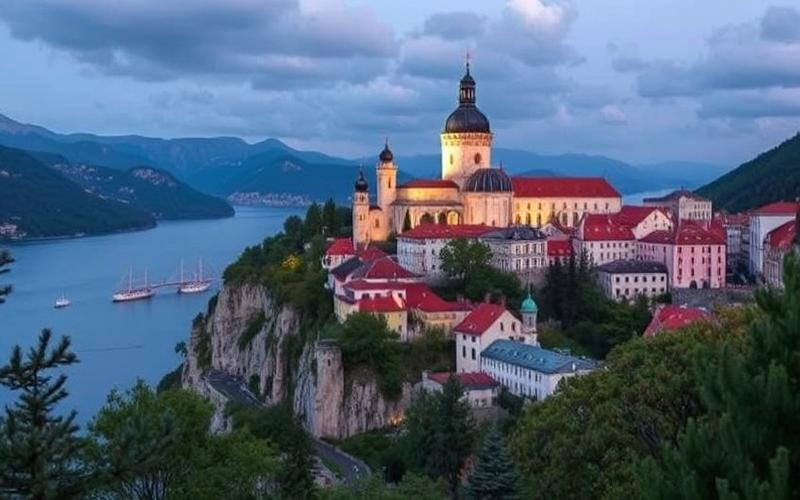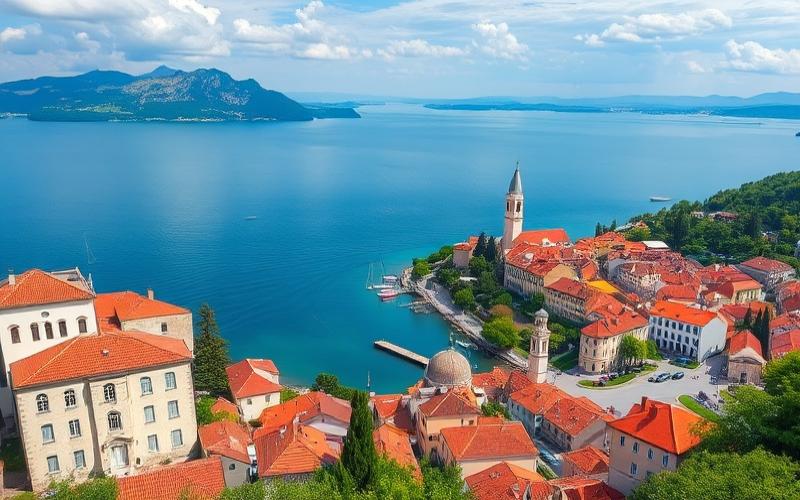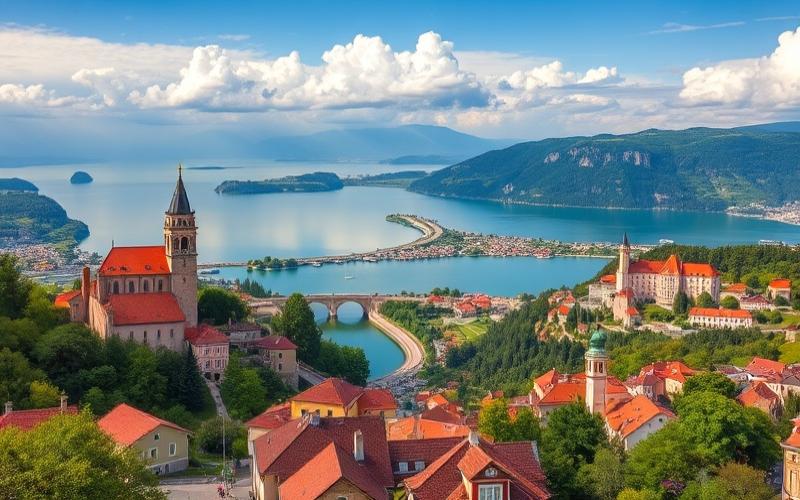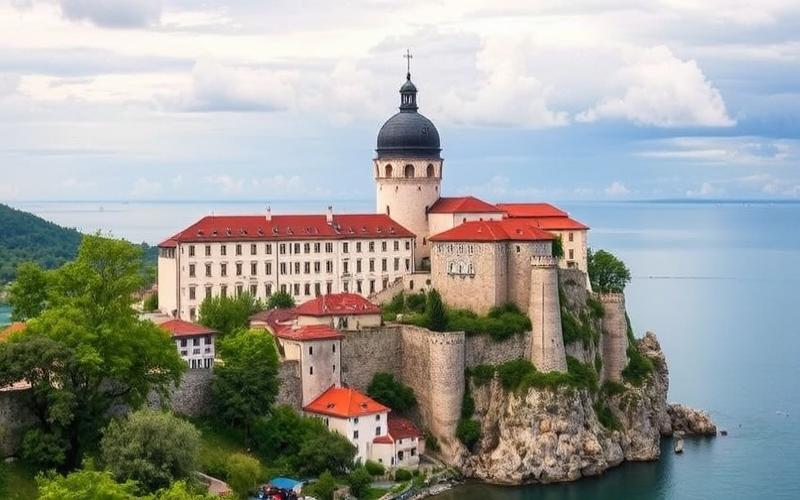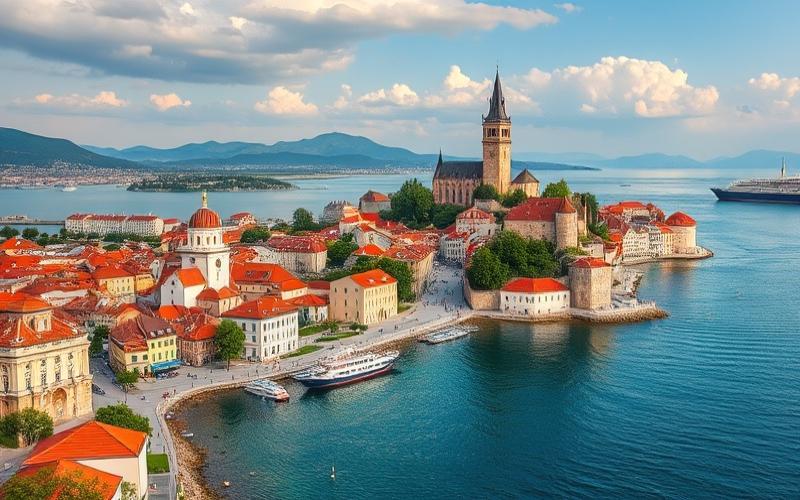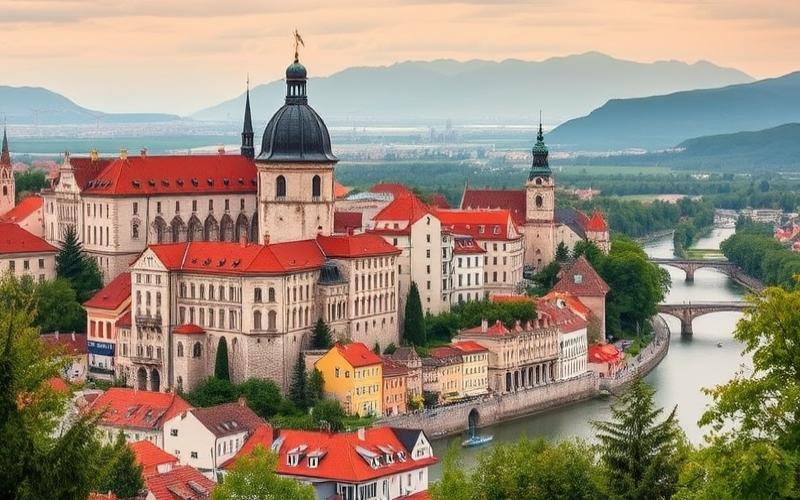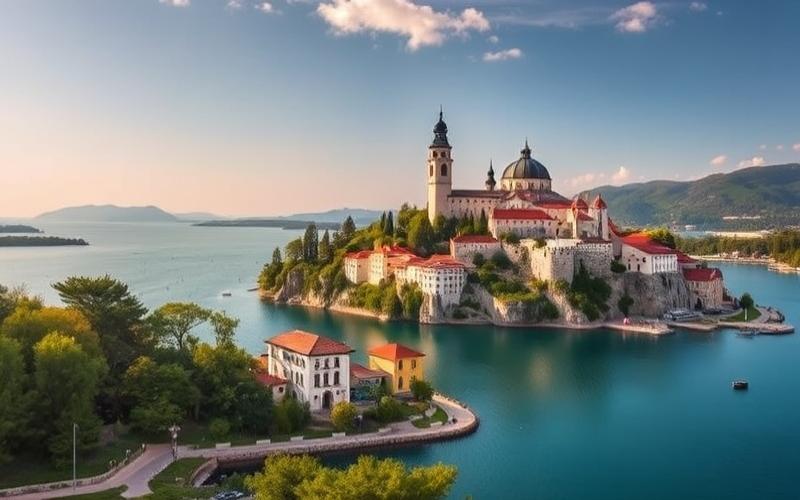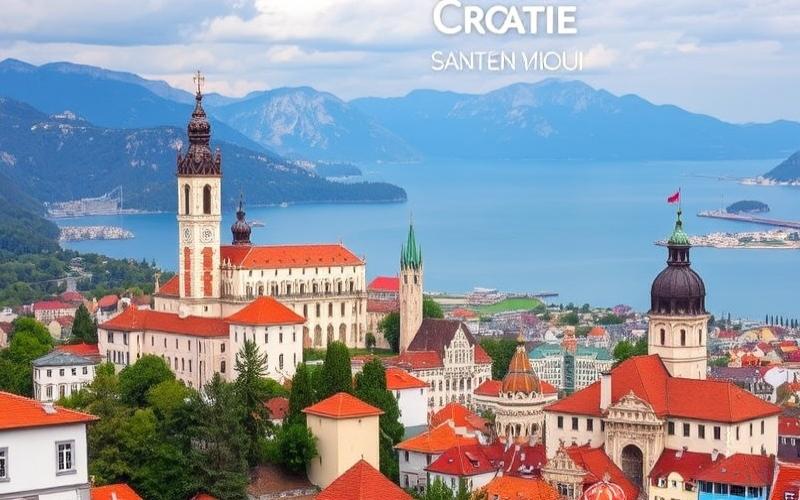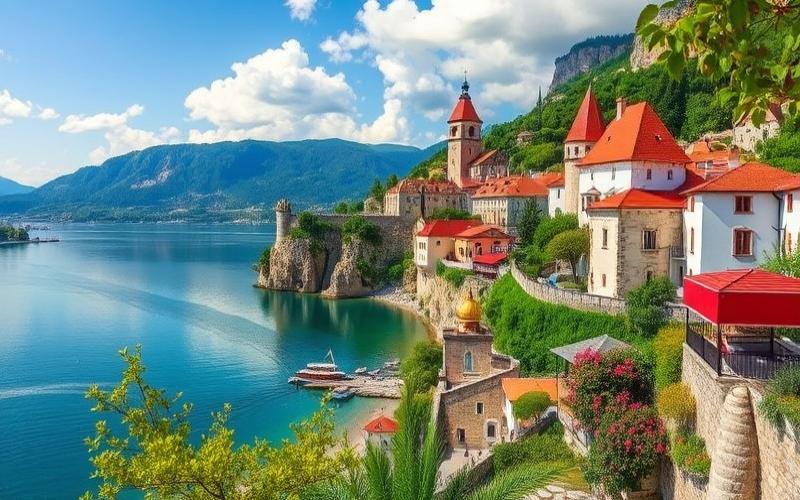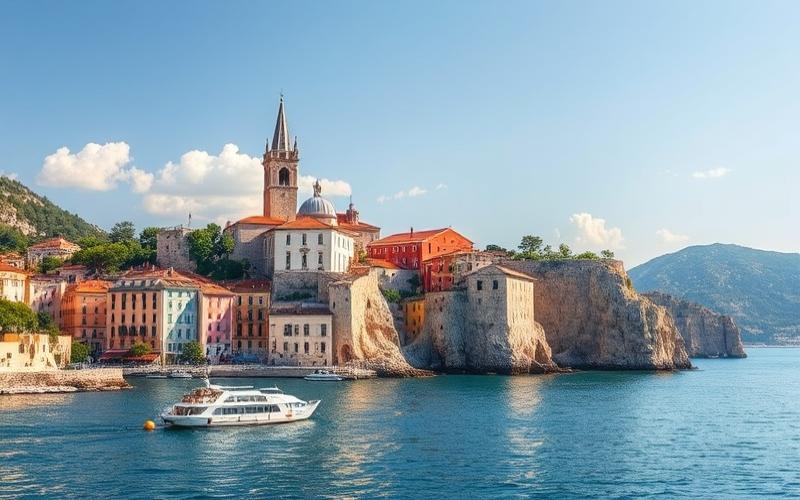
 Published on and written by Cyril Jarnias
Published on and written by Cyril Jarnias
Croatia, a Southeast European country, boasts a fascinating geography that combines picturesque Adriatic Sea coastlines with mountainous landscapes and fertile plains.
Home to numerous UNESCO World Heritage sites, such as the medieval city of Dubrovnik, the country is a true cultural and natural crossroads, highlighted by Plitvice and Krka National Parks.
Its numerous islands, approximately one thousand by official counts, add a unique dimension to its geography, while the Dinaric Alps mountains provide a spectacular backdrop.
Finally, its rich biodiversity and abundance of natural resources make Croatia an essential destination for any geography and nature enthusiast.
Croatia’s Geographic Location
Croatia is located in Southeastern Europe, at the crossroads of the Balkans and Central Europe, between the 42nd and 47th northern parallels. Its strategic position places it at the border of five countries: Slovenia to the northwest, Hungary to the northeast, Serbia to the east, Bosnia and Herzegovina to the southeast, and Montenegro to the far south.
| Neighboring Country | Direction from Croatia | Border Length |
|---|---|---|
| Slovenia | Northwest | 670 km |
| Hungary | Northeast | 329 km |
| Serbia | East | 245 km |
| Bosnia and Herzegovina | Southeast | 932 km |
| Montenegro | South | 25 km |
The Croatian territory, shaped like a horseshoe, is characterized by its maritime front on the Adriatic Sea stretching approximately 1,777 km of mainland coastline, plus over 4,000 km of island coastlines. This Adriatic access plays a major geopolitical and economic role, facilitating trade and access to pan-European corridors. Croatian ports serve as essential maritime outlets for landlocked countries such as Hungary, Slovakia, and Austria, strengthening Croatia’s position as a regional transit point.
Croatian geography is particularly diverse:
- Mountain ranges: the Dinaric Alps traverse the country from northwest to southeast, forming a natural barrier between the interior and the coast.
- Pannonian plains: to the east, the Slavonia region extends into vast fertile plains, favoring agriculture.
- Islands: Croatia has over 1,200 islands and islets, about fifty of which are inhabited, making it one of Europe’s most island-rich countries.
Main geographical regions:
- Slavonia: agricultural plain in the east, bordering Hungary and Serbia.
- Central Croatia: mountainous area around Zagreb and the Dinaric Alps.
- Dalmatia: long coastal and island region along the Adriatic.
- Istria: peninsula in the northwest, near Italy and Slovenia.
The impact of this geographic location on climate and biodiversity is significant:
- The coast and islands enjoy a Mediterranean climate: mild winters, hot and dry summers.
- The inland areas experience a continental climate: short, cool summers and long, harsh winters.
- This climatic diversity fosters great biodiversity, with numerous national parks, forests, wetlands, and rich flora and fauna both on the coast and in the mountains and plains.
Croatia, at the crossroads of Central Europe, the Balkans, and the Mediterranean, owes its natural diversity, role as a trade hub, and cultural richness to its geographic location.
Good to know:
Croatia, located in Southeastern Europe, shares borders with Slovenia, Hungary, Serbia, Bosnia and Herzegovina, and Montenegro, offering varied geography with the Dinaric Alps mountains, Pannonian plains, and its strategic access to the Adriatic Sea composed of numerous islands, influencing the Mediterranean climate and the country’s unique biodiversity.
Main Croatian Regions
Main Croatian regions and their geographical, cultural, and economic characteristics
| Region | Physical Characteristics | Climate | Main Cities | Natural Attractions | Geographic and Cultural Importance | Economy and Demographics |
|---|---|---|---|---|---|---|
| Slavonia | Vast fertile plain, traversed by the Drava, Sava, and Danube rivers, some isolated reliefs (Papuk, Medvednica mountains) | Continental climate with cold winters, hot summers | Osijek, Vukovar, Slavonski Brod, Požega | Kopački rit Nature Park, forests, rivers | Historic agricultural region, heart of grain production, Austro-Hungarian influences | Moderate population density, economy centered on agriculture and agribusiness, significant rural exodus |
| Central Croatia | Plains and hills around Zagreb, Medvednica, Bilogora, Zumberak mountains | Temperate continental | Zagreb, Varaždin, Karlovac | Medvednica Nature Park, Kupa and Sava rivers | Historic and political center, crossroads of Slavic, Ottoman, and Austro-Hungarian influences | Most urbanized and developed area, strong industrial and service activity, sustained demographic growth around Zagreb |
| Istria | Hilly peninsula, karst plateaus, indented coastlines | Mediterranean, mild winters, hot summers | Pula, Rovinj, Poreč | Baredine Caves, Kamenjak Cape, Adriatic coast | Strong regional identity, Venetian and Italian heritage, cultural mosaic | Dominant tourism economy, viticulture, stable demographics, high attractiveness for European retirees |
| Kvarner | Adriatic coast, deep bays, Krk, Cres islands | Mediterranean | Rijeka, Opatija | Islands, beaches, nearby mountains (Gorski kotar) | Transition region between Istria and Dalmatia, maritime influences | Industrial port (Rijeka), seaside tourism, dynamic urban demographics |
| Dalmatia | Narrow coastal strip, mountains (Velebit, Biokovo) plunging into the sea, archipelago of over 1,000 islands | Mediterranean, very sunny | Split, Zadar, Dubrovnik, Šibenik | Krka, Kornati National Parks, Plitvice (nearby), beaches, Hvar, Brač islands | Iconic region, ancient heritage (Split, Dubrovnik), Dalmatian culture, Venetian and Ottoman influences | High dependence on tourism, aging demographics on islands, urban growth in Split and Dubrovnik |
| Mountain Regions (Gorski kotar, Lika) | Mountainous terrain, dense forests, high karst plateaus, Velebit range | Mountain climate, harsh winters | Delnice, Gospić | Plitvice Lakes National Park, Velebit massif, caves | Transition zone, low density, pastoral traditions | Demographic decline, rural economy, nature tourism and winter sports |
Main climatic and natural influences
- The Pannonian plains (Slavonia, Central Croatia) are subject to a continental climate conducive to intensive agriculture.
- The Adriatic coast (Istria, Kvarner, Dalmatia) benefits from a Mediterranean climate, favoring viticulture, olive cultivation, and especially seaside tourism.
- The mountainous areas (Gorski kotar, Lika, Velebit) experience cold winters, dense forests, and a unique karst environment, attracting nature and hiking enthusiasts.
Economic and demographic differences
- Zagreb and its region concentrate the majority of infrastructure, working population, and industrial and service employment.
- Slavonia experiences demographic decline due to rural exodus and unemployment but remains the main agricultural breadbasket.
- The coast (Istria, Dalmatia) is more prosperous due to tourism and international openness, but rural and island areas suffer from depopulation.
- The mountainous regions are the least populated, with an economy mainly oriented towards forestry, livestock farming, and ecotourism.
Summary of regional assets and roles
- Slavonia: agricultural breadbasket, rural heritage, river importance.
- Central Croatia: political, industrial, and administrative heart.
- Istria: cultural crossroads, land of vineyards and high-end tourism.
- Kvarner: port and seaside interface.
- Dalmatia: symbol of Croatian tourism, major cultural and natural sites.
- Mountain Regions: green lung, nature reserve, low density.
Croatia’s geographical, climatic, and economic contrasts shape its cultural diversity and regional development, making each region an essential component of the national identity.
Good to know:
Dalmatia is renowned for its picturesque Adriatic coast and historic cities, while Slavonia, characterized by its vast plains, is Croatia’s wheat belt; in Istria, Italian influences strongly mark the local culture.
Croatia’s Largest Cities
| City | Population (2021) | Economic Role | Cultural/Historical Importance | Infrastructure and Development | Major Attractions | Urbanization & Environment |
|---|---|---|---|---|---|---|
| Zagreb | 663,592 inhab. (metro area: ~1.1 million) | Main industrial, financial, and scientific center of the country; driver of the national economy | Political and cultural capital, Austro-Hungarian heritage, dynamic artistic and intellectual life, numerous museums and festivals | Metro, tramway, international airport, development of modern districts, renovation of historic infrastructure | Cathedral, Mitteleuropa-style city center, museums, Dolac Market, cultural festivals | Growing urbanization, initiatives for sustainable mobility (public transport, pedestrian zones), urban greening plans |
| Split | 149,830 inhab. | Second economic hub of the country, major seaport, tourism, shipyards | Capital of Dalmatia, Roman heritage (Diocletian’s Palace), strong Mediterranean identity | Port, rail links, waterfront renovation, new residential areas | Diocletian’s Palace (UNESCO), Riva promenade, beaches, music and film festivals | Tourist pressure on the coast, heritage protection projects, preserved urban natural areas |
| Rijeka | 107,964 inhab. | Croatia’s primary port, maritime industry, logistics, international trade | Industrial and port city with a multicultural past, Austro-Hungarian influence, European Capital of Culture 2020 | Rail network, modernized port area, urban renewal, cultural spaces | Trsat Castle, Korzo, museums, Rijeka Carnival | Transition towards a green economy, port cleanup projects, enhancement of green spaces |
| Osijek | 75,535 inhab. | Economic center of Slavonia, agribusiness industries, universities, technology hubs | Historic eastern city, Baroque heritage, multiculturalism, Ottoman and Austrian fortifications | Modern road networks, university campus development, sports infrastructure | Citadel (Tvrđa), cathedral, museums, regional festivals | Efforts to revitalize the center, sustainable management of green spaces, combating rural exodus |
Key points on urban dynamics and sustainability in Croatia:
- Croatia is a predominantly urban society (57%) with a population concentrated in Zagreb and on the Adriatic coast.
- Urban growth is driven by the development of services, tourism, and industry but remains moderate outside major cities.
- Urbanization poses environmental challenges, including tourist pressure on the coast (Split, Rijeka), industrial pollution (Rijeka, Osijek), and preservation of historical heritage.
- Croatian cities are investing in soft mobility, energy renovation, waste management, and preservation of green spaces, with sustainable urban development initiatives (public transport in Zagreb, coastal protection in Split, cleanup in Rijeka).
Common tourist assets of major cities:
- UNESCO World Heritage sites (Split, proximity to sites in Zagreb and Rijeka)
- Major cultural festivals (music, film, folklore)
- Lively historic centers and traditional markets
- Access to the sea (Split, Rijeka), urban parks and rivers (Zagreb, Osijek)
The vitality of Croatia’s major cities lies in their ability to combine historical heritage, economic dynamism, and adaptation to contemporary urban sustainability challenges.
Good to know:
Zagreb, with approximately 800,000 inhabitants, is the country’s economic and cultural center, while Split, hosting nearly 180,000 people, stands out for its historical heritage and tourism growth; Rijeka and Osijek complete the urban landscape with sustainable initiatives to mitigate the impact of urbanization.
Disclaimer: The information provided on this website is for informational purposes only and does not constitute financial, legal, or professional advice. We encourage you to consult qualified experts before making any investment, real estate, or expatriation decisions. Although we strive to maintain up-to-date and accurate information, we do not guarantee the completeness, accuracy, or timeliness of the proposed content. As investment and expatriation involve risks, we disclaim any liability for potential losses or damages arising from the use of this site. Your use of this site confirms your acceptance of these terms and your understanding of the associated risks.





